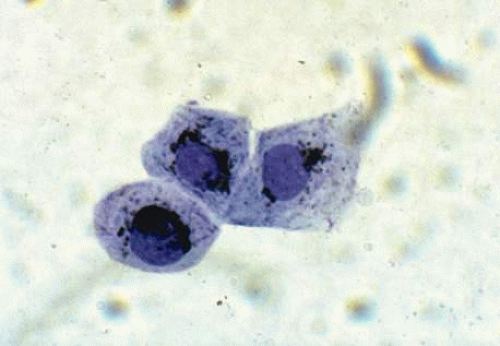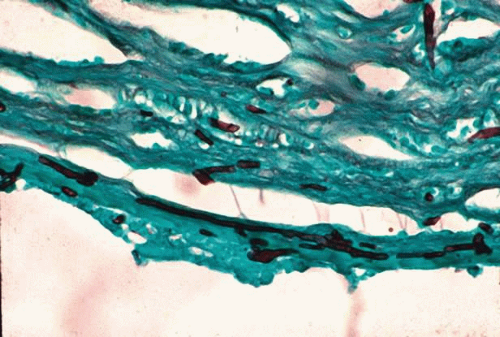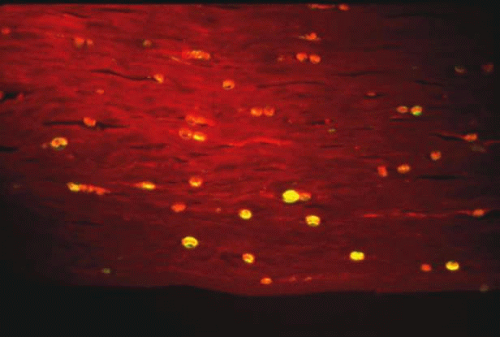Laboratory Diagnosis of Ocular Infectious Disease
Russell N. Van Gelder
Infectious disease remains a major cause of ocular morbidity throughout the world. Identification of the pathogenic organism responsible for a given ocular infection is critical to making the correct diagnosis, formulating a treatment plan, and providing an appropriate prognosis for the patient. The ophthalmologist must therefore be adept with the techniques of sample acquisition from a variety of ocular tissues, and have a working knowledge of the appropriate laboratory tests necessary for correct identification of pathogenic organisms.
A good working relationship with the clinical pathology laboratory is essential to ensure that samples are handled correctly. Many hospital and outpatient laboratories receive ophthalmic samples infrequently, which can lead to incorrect processing or even loss of valuable samples. For outpatient procedures, the laboratory should be contacted directly to ensure that the sample is processed correctly. For surgical biopsies, it is often advantageous to have the pathologist in the operating room at the time of sample acquisition to ensure that the often-miniscule biopsy tissue is handled appropriately.
There are four major means of laboratory identification of infectious organisms: direct observation, culture, serology, and molecular diagnostics. There are also four broad categories of pathogenic organisms affecting the eye: bacteria, fungi, viruses, and parasites. In this chapter, we consider each laboratory method in turn, highlighting the specifics of its application to each of the four categories of pathogens.
DIRECT OBSERVATION
Nearly all ophthalmic pathogens are microscopic; it is exceedingly rare to directly observe pathogenic organisms during the ophthalmic examination, although occasionally lice (i.e., Pediculus humanus spp. or Phthirus pubis) can be directly observed under the slit lamp in patients with chronic blepharitis. Far more frequently, direct observation requires obtaining tissue by methods such as scraping of a corneal ulcer, swabbing of acute purulent conjunctivitis, or vitreous aspiration in endophthalmitis, followed by light or electron microscopy with appropriate staining. Material from acute conjunctivitis can be obtained by swabbing the anesthetized conjunctiva with an alginate swab, whereas corneal samples are generally obtained with a sterilized Kimura spatula or needle. When sampling infected tissue, one should attempt to sample portions with active infection but without excessive necrosis. Care must be taken to identify samples from each swab carefully (e.g., right eye, left eye, lids, ulcer). For larger corneal ulcers, samples should be taken from several regions. Material can be applied directly to a glass slide as a thin smear and allowed to air dry.
BACTERIA
Most bacteria are not visible in unstained tissue. The standard initial staining method for identifying bacteria is Gram’s stain. To perform a Gram stain, the sample is spread on a slide, dried, and briefly fixed in methanol. It is then stained with a cresyl violet solution (i.e., Hucker’s solution) for 1 minute, rinsed in water, and then stained in Gram’s iodide for 1 minute. Following decolorization in 95% ethyl alcohol and a brief water rinse, the sample may be counterstained with safranin O. The entire procedure can be completed in less than 5 minutes. Gram-positive organisms resist the decolorization step and remain stained dark purple, whereas gram-negative bacteria have their cell wall permeability increased by the alcohol wash and thus decolorize; they are visualized by the pink counterstain. Table 1 lists common gram-positive and -negative organisms causing ophthalmic disease.
Table 1. Common Gram-Positive and Gram-Negative Bacteria Causing Ocular Disease | ||||||||||||||||||||||||||||||||||||||||||||||||||||||||||||||||||||||||||||
|---|---|---|---|---|---|---|---|---|---|---|---|---|---|---|---|---|---|---|---|---|---|---|---|---|---|---|---|---|---|---|---|---|---|---|---|---|---|---|---|---|---|---|---|---|---|---|---|---|---|---|---|---|---|---|---|---|---|---|---|---|---|---|---|---|---|---|---|---|---|---|---|---|---|---|---|---|
|
Certain bacteria are not readily visualized by Gram’s stain, and may require other stains or types of microscopy for visualization. Mycobacteria are most easily visible using acid-fast stains such as the Ziehl-Neelsen stain. Intracellular Chlamydia are not directly visible with Gram’s stain, and are generally visualized following Giemsa staining of intracellular inclusion bodies (Fig. 1). It is important to note that this Giemsa stain is the traditional 60-minute staining protocol; the brief Wright-Giemsa stain used for blood stains will not identify inclusion bodies. The Papanicolaou stain can also be used for the identification of Clamydia inclusions. Giemsa stain is also useful for the demonstration of Actinomyces and Nocardia species (which can also be seen on Gram’s staining). Darkfield microscopy can be used to demonstrate the Treponema pallidum spirochete of syphilis, although serologic testing is more commonly performed to confirm infection. Serologic testing is more commonly performed to confirm the traditional 60-minute Giemsa staining protocol; the brief Wright-Giemsa stain used for blood stains will not identify inclusion bodies. The Papanicolaou stain can also be used for the identification of Chlamydia inclusions.
 Fig. 1. Typical perinuclear intracytoplasmic inclusion bodies of Chlamydia in conjunctival cytologic preparation: Giemsa stain. (Photomicrograph courtesy of Dr. Morton Smith.) |
Certain direct fluorescent stains may be used in lieu of Gram’s strain for detection of bacteria. In particular, acridine orange has a much higher sensitivity for detection of bacteria than Gram’s stain, and has the additional advantage of staining fungi more reliably than Gram’s stain. The drawback of these direct fluorescent stains is the necessity of a fluorescent microscope for detection of the fluorescent signal. Positive specimens should be secondarily strained with Gram’s stain to identify the detected pathogen.
Commercial monoclonal or polyclonal antisera can be used to identify specific organisms by indirect immunofluorescence. In ophthalmology, this is commonly used for Chlamydia species.1 Because a specific antiserum must be used for each suspected organism, the requesting physician must communicate with the clinical microbiology or pathology laboratory in order to request these tests.
FUNGI
The most rapid technique for visualizing yeast or filamentous fungi is the potassium hydroxide (KOH) preparation. The scraping or swab is treated with 10% KOH in dimethyl sulfoxide. The strong base dissolves keratinized tissue (such as cornea), but the cell walls of fungi are resistant to dissolution. Both budding yeast and filamentous fungi can be visualized. Other staining methods also have high sensitivity for detection of yeast and fungi, including Giemsa stain, Gomori’s methenamine silver (GMS), India ink staining, or periodic acid–Schiff (PAS) stain (Fig. 2). Fungi can also be identified on some Gram-stained samples.
VIRUSES
Viruses are typically submicrometer in size and cannot be directly visualized by light microscopy. Characteristic cellular changes can sometimes be identified as, for example, the cytoplasmic inclusion bodies of herpes infection on hematoxylin-eosin–fixed sections or on the Tzanck smear (in which the fluid from a suspected herpetic vesicle is stained with Giemsa, Papanicolaou, and Wright’s stain; multinucleated giant cells indicate herpetic infection). Viruses can be directly observed by electron microscopy, but this is rarely used clinically because of the difficulty in specimen preparation and the low yield of positive results. Specific antisera for many viruses are available, and can be used to identify virally infected cells; however, this technique is typically used in research settings because it generally requires fixed biopsy tissue with preserved cytoarchitecture.
PARASITES
Some parasites can be seen free living under the microscope. Onchocerca volvulus, the causative agent of river blindness, can be directly observed swimming out of skin or corneal biopsies incubated in saline or culture medium. Modern imaging techniques are increasing the range of organisms that can be directly detected in situ. In particular, the confocal microscope has been successfully used to visualize Acanthamoeba in infected corneas.2 Certain parasites causing ophthalmic disease can be visualized with special stains. Acanthamoeba species can be visualized on corneal scrapings with PAS or GMS stains, or with the fluorescent dyes calcifluor white or acridine orange (Fig. 3). Both techniques require a fluorescent microscope to visualize the dye. Calcifluor white (a whitening agent used in laundry detergents) stains Acanthamoeba cell walls and fluoresces green under ultraviolet illumination. Toxoplasma gondii can be visualized with PAS or GMS stains from biopsy material. Specific antisera can be used in stains of biopsy specimens.
CULTURE
The ability to grow organisms in vitro is the mainstay of pathogen identification for bacteria and some fungi. In addition to allowing a variety of metabolic tests to be run for precise identification of microbial organisms, antibiotic resistance can also be assayed.
Correct handling of material to be cultured is critical to achieving good yields on these diagnostic tests. Ocular surface or intraocular samples suspected of bacterial or fungal infection should be plated or inoculated on multiple media. Blood agar is useful for isolation of aerobic bacteria when grown at 37°C and may yield cultures of saprophytic fungi when grown at room temperature. Chocolate agar is useful for growing Haemophilus, Neisseria, and Moraxella cultures, and must be grown under 5% to 10% carbon dioxide. For isolation of most fungi, either Sabouraud’s dextrose agar or brain-heart infusion media should be used and grown at room temperature. Finally, anaerobic bacteria may be isolated from thioglycolate broth. Specific media for other indications are discussed below.
Stay updated, free articles. Join our Telegram channel

Full access? Get Clinical Tree




